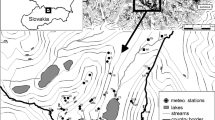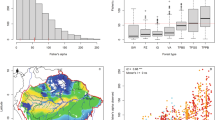Abstract
Improved sampling designs are needed to detect, monitor, and predict plant migrations and plant diversity changes caused by climate change and other human activities. We propose a methodology based on multi-scale vegetation plots established across forest ecotones which provide baseline data on patterns of plant diversity, invasions of exotic plant species, and plant migrations at landscape scales in Rocky Mountain National Park, Colorado, USA. We established forty two 1000-m2 plots in relatively homogeneous forest types and the ecotones between them on 14 vegetation transects. We found that 64% of the variance in understory species distributions at landscape scales were described generally by gradients of elevation and under-canopy solar radiation. Superimposed on broad-scale climatic gradients are small-scale gradients characterized by patches of light, pockets of fertile soil, and zones of high soil moisture. Eighteen of the 42 plots contained at least one exotic species; monitoring exotic plant invasions provides a means to assess changes in native plant diversity and plant migrations. Plant species showed weak affinities to overstory vegetation types, with 43% of the plant species found in three or more vegetation types. Replicate transects along several environmental gradients may provide the means to monitor plant diversity and species migrations at landscape scales because: (1) ecotones may play crucial roles in expanding the geophysiological ranges of many plant species; (2) low affinities of understory species to overstory forest types may predispose vegetation types to be resilient to rapid environmental change; and (3) ecotones may help buffer plant species from extirpation and extinction.
Similar content being viewed by others
References
Allen RB, Peet RK and Baker WL (1991) Gradient analysis of latitudinal variation in southern Rocky Mountain forests. Journal of Biogeography 18: 123–139
Backéus I (1993) Ecotone versus ecocline: vegetation zonation and dynamics around a small reservoir in Tanzania.Journal of Biogeography 20: 209–218
Baker WL and Weisberg PJ (1997) Using GIS to model tree population parameters in the Rocky Mountain National Park forest-tundra ecotone. Journal of Biogeography 24: 513–526
Baker WL, Munroe JA and Hessl AE (1997) The effect of elk on aspen population in the winter range of Rocky Mountain National Park, Colorado, USA. Ecography 20: 155–165
Barbour MG, Burk JH and Pitts WD (1987) Terrestrial Plant Ecology, 2nd edn. Benjamin/Cummings, Menlo Park, California
Bartlein PJ, Whitlock C and Shafer SL (1997) Future change in the Yellowstone National Park region and its potential impact on vegetation. Conservation Biology 11: 782–792
Bazzaz FA (1996) Plants in Changing Environments. Cambridge University Press, New York
Clements FE (1916) Plant Succession: An Analysis of the Development of Vegetation. Publication 242. Carnegie Institution of Washington, Washington, DC
Coughenour MB (1993) Savanna-Landscape and Regional Ecosystem Model: Documentation. Natural Resource Ecology Laboratory, Colorado State University, Fort Collins, Colorado
Cornelius JM and Reynolds JF (1991) On determining the statistical significance of discontinuities within ordered ecological data. Ecology 72: 2057–2070
Crumley CL (1993) Analyzing historic ecotonal shifts. Ecological Applications 3: 377–384
Daubenmire RF (1968) Plant Communities: A Textbook of Plant Synecology. Harper and Row, New York
Davis MB (1991) Insights from paleoecology on global change. Ecol. Soc. Am. Bull. 70: 222–228
Foley JA, Prentice IC, Ramankutty N, Levis S, Pollard D, Sitch S and Haxeltine A (1996) An integrated biosphere model of land surface processes, terrestrial carbon balance and vegetation dynamics. Global Biogeoch. Cycles 10: 603–628
Fortin M (1994) Edge detection algorithms for two-dimensional ecological data. Ecology 75: 956–965
Giesler R, Högberg M and Högberg P (1998) Soil chemistry and plants in Fennoscandian boreal forest as exemplified by a local gradient. Ecology 79: 119–137
Gillison AN (1970) Structural and floristics of a montane grassland/forest transition, Doma Peaks Region, Papua. Blumea 18: 71–86
Gleason HA (1926) The individualistic concept of the plant association. Bulletin of the Torrey Botanical Club 53: 1–20
Gosz JR (1993) Ecotone hierarchies. Ecological Applications 3: 369–376
Grabherr G, Gottfried M and Pauli H (1994) Climate effects on mountain plants. Nature 369: 448
Grace JB and Pugesek BH (1997) A structural equation model of plant species richness and its application to a coastal wetland. The American Naturalist 149: 436–460
Hadley KS and Veblen TT (1993) Stand response to western spruce budworm and Douglas-fir bark beetle outbreaks, Colorado Front Range. Canadian Journal of Forest Research 23: 479–491
Hansen AJ and di Castri F (eds) (1992) Landscape Boundaries: Consequences for Biotic Diversity and Landscape Flows. Ecological Studies 92. Springer-Verlag, New York
Holland MM, Risser PG and Naiman RJ (eds) (1991) Ecotones. Chapman & Hall, New York
Kareiva PM and Anderson M (1988) Spatial aspects of species interactions: The wedding of models and experiments. In: Hastings A (ed) Community Ecology, pp 35–50. Lecture Notes in Biomathematics 77. Springer-Verlag, Berlin
Kieft TL, White CS, Loftin SR, Aguilar R, Craig JA and Skaar DA (1998) Temporal dynamics in soil carbon and nitrogen resources at a grassland-shrubland ecotone. Ecology 79: 671–683
Krebs CJ (1989) Ecological Methodology. Harper and Row, New York
Kullman L (1996) Norway spruce present in the Scandes Mountains, Sweden, at 8000 BP: new light on Holocene tree spread. Global Ecology and Biogeog. Letters 5: 94–101
Mack RN (1986) Alien plant invasion into the Intermountain West: A case history. In: Mooney HA and Drake JA (eds) Ecology of Biological Invasions of North America and Hawaii, pp 191–212. Springer-Verlag, New York
Madole RF (1976) Glacial geology of the Front Range, Colorado. In: Mahaney WC (ed) Quaternary Stratigraphy of North America, pp 319–351. Dowden, Hutchinson, and Ross, Stroudsburg, Pennsylvania
Markgraf V and Scott L (1981) Lower timberline in central Colorado during the past 15,000 yr. Geology 9: 231–234
Martinez E and Fuentes E (1993) Can we extrapolate the California model of grassland-shrubland ecotone? Ecological Applications 3: 417–423
Milne BT, Johnson AR, Keith TH, Hatfield CA, David J and Hraber PT (1996) Detection of critical densities associated with piñyon-juniper woodland ecotones. Ecology 77: 805–821
Montaña C, Lopez-Portillo J and Mauchamp A (1990) The response of two woody species to the conditions created by a shifting ecotone in an arid ecosystem. Journal of Ecology 78: 789–798
Mueller-Dombois D and Ellenberg H (1974) Aims and Methods of Vegetation Ecology. Wiley, New York
Neilson RP (1991) Climatic constraints and issues of scale controlling regional biomes. In: Holland MM, Naiman RJ, and Risser PG (eds) Role of Landscape Boundaries in the Management and Restoration of Changing Environments, pp 31–51. Chapman & Hall, New York
Neilson RP (1995) A model for predicting continental-scale vegetation distribution and water balance. Ecological Applications 5: 362–385
Neter J, Wasserman W and Kutner MH (1990) Applied Linear Statistical Models: Regression, Analysis of Variance, and Experimental Designs, 3rd edn. Irwin, Homewood, Illinois
Palmer MW (1993) Putting things in even better order: The advantages of canonical correspondence analysis. Ecology 74: 2215–2230
Peet RK (1981) Forest vegetation of the Colorado Front Range. Vegetatio 45: 3–75
Peet RK (1988) Forests of the Rocky Mountains. In: Barbour MG and Billings WD (eds)North American Terrestrial Vegetation, pp 63–101. Cambridge University Press, New York
Peters RL and Darling JD (1985) The greenhouse effect and nature reserves. BioScience 35: 707–717
Pitelka LF and the Plant Migration Workshop Group (1997) Plant migration and climate change. American Scientist 85: 464–473
Puyravaud J, Pascal J and Dufour C (1994) Ecotone structure as an indicator of changing forest-savanna boundaries (Linganamakki Region, southern India). Journal of Biogeography 21: 581–593
Reed RA, Peet RK, Palmer MWand White PS (1993) Scale dependence of vegetation-environment correlations: A case study of a North Carolina piedmont woodland. Journal of Vegetation Science 4: 329–340
Risser PG (1993) Ecotones: Ecotones at local to regional scales from around the world. Ecological Applications 3: 367–368
Risser PG (1995) The status of the science of examining ecotones. BioScience 45: 318–325
Romme WH and Turner MG (1991) Implications of global change for biogeographic patterns in the Greater Yellowstone Ecosystem. Conservation Biology 5: 373–386
Rusek J (1993) Air-pollution-mediated changes in alpine ecosystems and ecotones. Ecological Applications 3: 406–416
Stohlgren TJ (1992) Resilience of a heavily logged grove of giant sequoia (Sequoiadendron giganteum) in Kings Canyon National Park, California. Forest Ecology and Management 54: 115–140
Stohlgren TJ (1993) Spatial patterns of giant sequoia (Sequoiadendron giganteum) in two sequoia groves in Sequoia Canyon National Park, California. Canadian Journal of Forest Research 23: 120–132
Stohlgren TJ, Falkner MB and Schell LD (1995) A modified-Whittaker nested vegetation sampling method. Vegetatio 117: 113–121
Stohlgren TJ and Bachand RR (1997) Lodgepole pine (Pinus contorta) ecotones in Rocky Mountain National Park, Colorado, USA. Ecology 78: 623–641
Stohlgren TJ, Chong GW, Kalkhan MA and Schell LD (1997a) Multi-scale sampling of plant diversity: effects of the minimum mapping unit. Ecological Applications 7: 1064–1074
Stohlgren TJ, Chong GW, Kalkhan MA and Schell LD (1997b) Rapid assessment of plant diversity patterns: a methodology for landscapes. Env. Monit. Assessment 48: 25–43
Stohlgren TJ, Coughenour MB, Chong GW, Binkley D, Kalkhan MA, Schell LD, Buckley DJ and Berry JK (1997c) Landscape analysis of plant diversity. Landscape Ecology 12: 155–170
Stohlgren TJ, Bachand RR, Onami Y and Binkley D (1998a) Species-environment relationships and vegetation patterns: effects of scale and tree life-stage. Plant Ecology 135: 215–228
Stohlgren TJ, Bull KA and Otsuki, Y (1998b) Comparison of rangeland sampling techniques in the Central Grasslands. Journal of Range Management 51: 164–172
Stohlgren TJ, Chase TN, Pielke RA Sr, Kittel TGF, and Baron JS (1998c) Evidence that local land use practices influence regional climate, vegetation, and stream flow patterns in adjacent natural areas. Global Change Biology 4: 495–504
Stohlgren TJ, Binkley D, Chong GW, Kalkhan MA, Schell LD, Bull KA, Otsuki Y, Newman G, Bashkin M and Son Y (1999a) Exotic plant species invade hot spots of native plant diversity. Ecological Monographs 69: 25–46
Stohlgren TJ, Schell LD and Vanden Heuvel B (1999b) How grazing and soil quality affect native and exotic plant diversity in Rocky Mountain grasslands. Ecological Applications 9: 45–64
Suzuki K (1997) Aspen regeneration in the elk winter range of Rocky Mountain National Park. Masters thesis. Colorado State University, Fort Collins, Colorado
Sykes MT and Prentice IC (1996) Climate change, tree species distributions and forest dynamics: A case study in the mixed conifer/hardwoods zone of northern Europe. Climatic Change 34: 161–177
ter Braak CJF (1986) Canonical correspondence analysis: a new eigen vector technique for multivariate direct gradient analysis. Ecology 67: 1167–1179
ter Braak CJF (1987a) The analysis of vegetation-environment relationships by canonical correspondence analysis. Vegetatio 69: 69–77
ter Braak CJF (1987b) CANOCO-a FORTRAN program for canonical community ordination by [partial] [detrended] [canonical] correspondence analysis, principal components analysis and redundancy analysis (version 2.1) Wageningen, The Netherlands: TNO Institute of Applied Computer Science
ter Braak CJF (1991) CANOCO version 3.12. Agricultural Mathematics Group, Wageningen, The Netherlands
Vitousek PM, D'Antonio CM, Loope LL and Westbrooks R (1996) Biological invasions as global environmental change. American Scientist 84: 468–478
Weisberg PJ and Baker WL (1995) Spatial variation in tree regeneration in the forest-tundra ecotone, Rocky Mountain National Park, Colorado. Canadian Journal of Forest Research 25: 1326–1339
Wesser SD and Armbruster WS (1991) Species distribution controls across a forest-steppe transition: a causal model and experimental test. Ecological Monographs 61: 323–342
Whitlock C (1993) Post-glacial vegetation and climate of Grand Teton and southern Yellowstone national parks. Ecological Monographs 63: 173–198
Whittaker RH (1967) Gradient analysis of vegetation. Biol. Rev. 42: 207–264
Wiens JA, Crawford CS and Gosz JR (1985) Boundary dynamics: a conceptual framework for studying landscape ecosystems. Oikos 45: 421–427
Woods KD and Davis MB (1989) Paleoecology of range limits: Beech in the Upper Peninsula of Michigan. Ecology 70: 681–696
Woodward FI (1993) The lowland-to-upland transition-modeling plant responses to environmental change. Ecological Applications 3: 404–408
Zar JH (1974) Biostatistical Analysis. Prentice-Hall, Englewood Cliffs, New Jersey
Author information
Authors and Affiliations
Rights and permissions
About this article
Cite this article
Stohlgren, T.J., Owen, A.J. & Lee, M. Monitoring shifts in plant diversity in response to climate change: a method for landscapes. Biodiversity and Conservation 9, 65–86 (2000). https://doi.org/10.1023/A:1008995726486
Issue Date:
DOI: https://doi.org/10.1023/A:1008995726486




